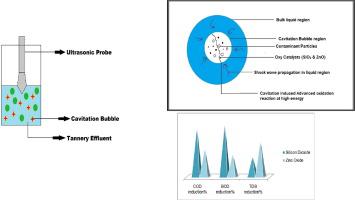当前位置:
X-MOL 学术
›
Arab. J. Chem.
›
论文详情
Our official English website, www.x-mol.net, welcomes your
feedback! (Note: you will need to create a separate account there.)
Comparative Studies on Ultrasound Assisted Treatment of Tannery Effluent using Multiple Oxy-Catalysts using Response Surface Methodology
Arabian Journal of Chemistry ( IF 5.3 ) Pub Date : 2020-09-01 , DOI: 10.1016/j.arabjc.2020.07.012 Saravanan Jeganathan , Kannan Kandasamy , Sangeetha Velusamy , Pranav Sankaran
Arabian Journal of Chemistry ( IF 5.3 ) Pub Date : 2020-09-01 , DOI: 10.1016/j.arabjc.2020.07.012 Saravanan Jeganathan , Kannan Kandasamy , Sangeetha Velusamy , Pranav Sankaran

|
Abstract Advanced oxidation of wastewater is a promising technique for tannery wastewater treatment, as it consumes less chemical addition and energy and it doesn’t liberate any secondary effluents. However, advanced oxidation can be improved by conjoining it with energy sources like ultraviolet radiation, ultrasound, etc. Catalysts capable of oxidation like titanium dioxide and iron oxide have been utilized for advanced oxidation of tannery effluent. The present work studies the synergic effect of ultrasound assisted advanced oxidation using two oxy-catalysts, namely zinc oxide and silicon dioxide. The effect of variables like time of treatment, catalyst loading, and power of ultrasound on the reduction of BOD, COD, and TDS were estimated and the results indicated a proficient reduction of contaminants. Upon treatment with silicon dioxide under ultrasound, the COD, BOD, and TDS reduction were found to be 88%, 89%, and 88% respectively, while zinc oxide catalyst indicated 89%, 85%, and 88% reduction. Response Surface Methodology has been utilized for derivation of a mathematical model for COD, BOD and TDS reduction. The spent catalysts were analyzed using Scanning Electron Microscopy and X-ray Diffraction to understand the changes in the characteristics of the spent catalyst. The deposition of contaminants on the catalysts and slight changes in the surface morphology were evident. Hence silicon dioxide and zinc oxide are promising catalysts for the treatment of tannery effluent combined with ultrasound.
中文翻译:

使用响应面法的多氧催化剂超声辅助处理制革废水的比较研究
摘要 废水深度氧化是一种有前景的制革废水处理技术,因为它消耗的化学添加剂和能量少,而且不释放任何二次废水。然而,高级氧化可以通过将其与紫外线辐射、超声波等能源结合来改善。能够氧化的催化剂,如二氧化钛和氧化铁,已被用于制革废水的高级氧化。目前的工作研究了使用两种氧催化剂,即氧化锌和二氧化硅的超声辅助高级氧化的协同作用。估计了诸如处理时间、催化剂负载和超声功率等变量对 BOD、COD 和 TDS 减少的影响,结果表明污染物的有效减少。在超声波下用二氧化硅处理后,发现 COD、BOD 和 TDS 减少分别为 88%、89% 和 88%,而氧化锌催化剂表明减少了 89%、85% 和 88%。响应面方法已用于推导 COD、BOD 和 TDS 减少的数学模型。使用扫描电子显微镜和 X 射线衍射对废催化剂进行分析,以了解废催化剂特性的变化。污染物在催化剂上的沉积和表面形态的轻微变化是明显的。因此,二氧化硅和氧化锌是结合超声波处理制革废水的有前途的催化剂。和 88% 的减少。响应面方法已用于推导 COD、BOD 和 TDS 减少的数学模型。使用扫描电子显微镜和 X 射线衍射对废催化剂进行分析,以了解废催化剂特性的变化。污染物在催化剂上的沉积和表面形态的轻微变化是明显的。因此,二氧化硅和氧化锌是结合超声波处理制革废水的有前途的催化剂。和 88% 的减少。响应面方法已用于推导 COD、BOD 和 TDS 减少的数学模型。使用扫描电子显微镜和 X 射线衍射对废催化剂进行分析,以了解废催化剂特性的变化。污染物在催化剂上的沉积和表面形态的轻微变化是明显的。因此,二氧化硅和氧化锌是结合超声波处理制革废水的有前途的催化剂。污染物在催化剂上的沉积和表面形态的轻微变化是明显的。因此,二氧化硅和氧化锌是结合超声波处理制革废水的有前途的催化剂。污染物在催化剂上的沉积和表面形态的轻微变化是明显的。因此,二氧化硅和氧化锌是结合超声波处理制革废水的有前途的催化剂。
更新日期:2020-09-01
中文翻译:

使用响应面法的多氧催化剂超声辅助处理制革废水的比较研究
摘要 废水深度氧化是一种有前景的制革废水处理技术,因为它消耗的化学添加剂和能量少,而且不释放任何二次废水。然而,高级氧化可以通过将其与紫外线辐射、超声波等能源结合来改善。能够氧化的催化剂,如二氧化钛和氧化铁,已被用于制革废水的高级氧化。目前的工作研究了使用两种氧催化剂,即氧化锌和二氧化硅的超声辅助高级氧化的协同作用。估计了诸如处理时间、催化剂负载和超声功率等变量对 BOD、COD 和 TDS 减少的影响,结果表明污染物的有效减少。在超声波下用二氧化硅处理后,发现 COD、BOD 和 TDS 减少分别为 88%、89% 和 88%,而氧化锌催化剂表明减少了 89%、85% 和 88%。响应面方法已用于推导 COD、BOD 和 TDS 减少的数学模型。使用扫描电子显微镜和 X 射线衍射对废催化剂进行分析,以了解废催化剂特性的变化。污染物在催化剂上的沉积和表面形态的轻微变化是明显的。因此,二氧化硅和氧化锌是结合超声波处理制革废水的有前途的催化剂。和 88% 的减少。响应面方法已用于推导 COD、BOD 和 TDS 减少的数学模型。使用扫描电子显微镜和 X 射线衍射对废催化剂进行分析,以了解废催化剂特性的变化。污染物在催化剂上的沉积和表面形态的轻微变化是明显的。因此,二氧化硅和氧化锌是结合超声波处理制革废水的有前途的催化剂。和 88% 的减少。响应面方法已用于推导 COD、BOD 和 TDS 减少的数学模型。使用扫描电子显微镜和 X 射线衍射对废催化剂进行分析,以了解废催化剂特性的变化。污染物在催化剂上的沉积和表面形态的轻微变化是明显的。因此,二氧化硅和氧化锌是结合超声波处理制革废水的有前途的催化剂。污染物在催化剂上的沉积和表面形态的轻微变化是明显的。因此,二氧化硅和氧化锌是结合超声波处理制革废水的有前途的催化剂。污染物在催化剂上的沉积和表面形态的轻微变化是明显的。因此,二氧化硅和氧化锌是结合超声波处理制革废水的有前途的催化剂。











































 京公网安备 11010802027423号
京公网安备 11010802027423号